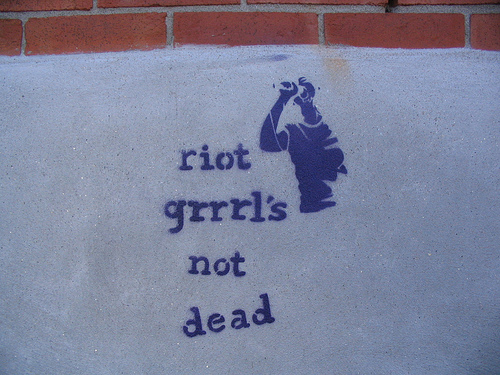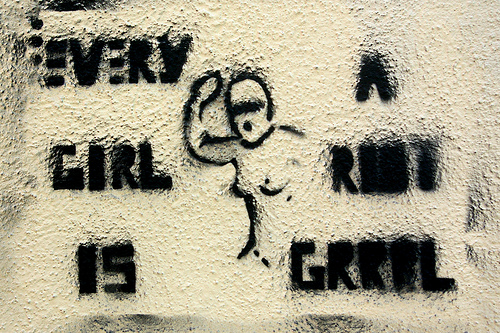This is the final blog post in this special interview series, within which Megan Sormus (Northumbria University) talked to Girl Museum about Riot Grrrl and her own ideas about girlhood. Passionate about music and music scenes herself, Megan talks about the expectations placed on girls in the UK, the ways in which she explored her own girlhood identity and the important role that music has played in this journey.
Check out our previous posts, Alternative Girl: I wanna be a Riot Grrrl! and Alternative Girl: Introducing Riot Grrrls for more!
How do you view the current expectations of girls in your culture?
“Currently, I feel expectations of girls in contemporary culture to be in a state of flux, primarily due to two main reasons. The first is the mediatising of young female celebrities that have come of age in the public eye. For example, the contention surrounding Miley Cyrus’ girl identity, and so the transitional experience of ‘becoming a woman’ is made very public and often, in the case of Miley, viewed as outrageous as when her newly alternative and provocative image hit the headlines, it defied the girl-next-door identity and expectations of Hannah Montana, a guise with which she shot to fame in the first place. The second ties in with the former and is located through the prominence popular culture places onto changing fashions: there is still quite a large emphasis and pressure put onto young women to follow particular fashions and with this, mimic idealised images of femininity perpetuated by mainstream culture, or, alternatively, take up the image of ‘bad’ role models such as Miley Cyrus. With this, young women risk sparking outrage or be criticised for being fake or performative, while all the time just exploring their fluctuating role as a girl and attempts to explore alternative routes.
“Despite obvious problems with girls (especially celebrity girls) defying exceptions in mainstream culture, I feel that freedom granted to girls to switch between identities in an explorative way is ultimately a positive thing, especially in terms of fashion. With the increasing interest in riot grrrl, there has been a push for ‘alternative’ ways of dressing and behaving more than I experienced when I was in my teens. A few major examples of this include the resurgence of ‘grunge’ fashion, the increased popularity of Dr. Martens, and with this the appropriation of traditional, and admittedly androgynous skinhead styles, with girls donning more masculine aesthetics including Chelsea haircuts, Harrington jackets, jeans and braces. Some may argue that there is an element of frustration surrounding individuals merely buying into fashions just because they’re told to do so, without any real interest (Miley received a lot of criticism in these terms). I would agree that the popularising of anything that was intended to define a subculture against the mainstream is annoying when appropriated by popular culture as to some extent it does belittle the rebellious intent. Yet, the position I have now taken, stemming from the fact I am returning to this subject older and to some extent from a position of retrospect, I alternatively feel a positive spin could be placed on it the sense that it forces girls who might be open or inquisitive to hunt down the story behind the fashions, rather than just following these fashions because there is a cultural expectation for them to do so. For example, there is a wealth of feminist politics behind things like riot grrrl that animates feminism for young women in the twenty-first century- which is especially advantageous as feminism is often shied away from by young women, viewed as dull, defunct, dead, or just ultimately just a ‘dirty’ word. I feel that by blending their own identities with these ‘alternative’ fashions, girls also unearth alternative prospects that interfere with mainstream expectations and introduce a feminist politics to the terrain of girl culture that they may perhaps have been unaware of.”
What can we do to explore our own girl identity?
“As it is a primary interest of mine, I have attended many gigs of bands that have female front women (a few examples being Savages, and The Julie Ruin whose lead singer, Kathleen Hanna, was prolific in the riot grrrl scene). In viewing first hand the way these women interact with their space, I believe the key way to explore girl identity is to be bold: boldness confronts, which then leads to the conflict and breakdown of idealisations and expectations placed on young women in contemporary society. The confidence to challenge what is accepted is essential in order to keep girl identity fluid, contradictory, fun, and most importantly, imperfect so as to confront any restrictions placed on the cultural construction and mainstream idealisations of girlhood. If the conventional female image is not completely escapable due to its unrelenting visibility in mainstream culture, then young women must use this as the basis for their movement to an assertive and contradictory femininity. To quote Kathleen Hanna, ‘if there’s nothing natural about me, then I might as well be the best construct ever’.”
This is just a taste of what Girl Museum has in store for you during our 2017 exhibition, Alternative Girl. We are in the process of building an exciting exhibition, gathering together inspirational girls and women who have produced, promoted and used music to create their own alternative identities. As ever, our exhibitions wouldn’t be the same without your contributions!
If music (or musical girls) has played in important part in your life in any way, get in contact with us. Maybe you want to write a guest blog post, create some artwork for us to use in the exhibition, write a profile of a female musician that has influenced you or send in a video of your own band performing. Whatever it is about music that inspires you, we want to know! Email your ideas and suggestions to me at sarahr@girlmuseum.org.
-Sarah Raine
Junior Girl
Girl Museum Inc.


